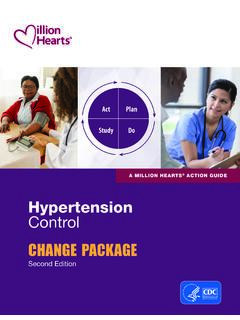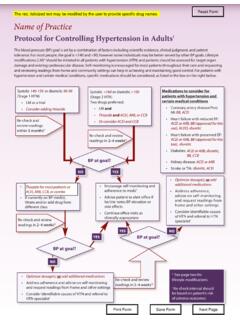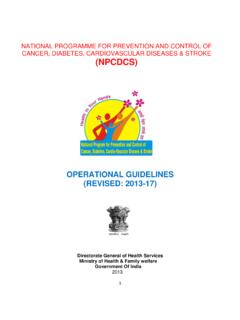Transcription of Protocol for Identifying and Treating Patients
1 Protocol for Identifying and Treating Patients Who Use TobaccoProtocol for Identifying and Treating Patients Who Use tobacco No level of smoking or tobacco use is tobacco addiction is a chronic condition, often requiring multiple quit attempts for a tobacco user to become tobacco There are effective, evidence-based, brief clinical interventions available to help Patients who smoke. The intervention protocol2 below can be integrated into the tobacco use identification and intervention clinical workflow for every patient aged 13 years and older. This Protocol can also serve as a model to build clinical decision support into the electronic health record (EHR) to achieve tobacco use intervention goals. In terms of the core components of a clinical tobacco cessation intervention, all Patients can benefit from behavioral counseling. All Patients 13 and older, with the exception of pregnant women, adolescents, light smokers, and smokeless tobacco users (due to insufficient evidence), can benefit from medication.
2 The combination of counseling and medication is most effective, and both should form the foundation of a brief cessation intervention. 2 It is important to monitor Patients during their quit attempt for behavioral and medication adherence, efficacy, and side-effects, to provide support, and to offer continued assistance in the case of slips or relapses to tobacco use. tobacco cessation Brief Clinical Intervention Protocol2 ASK Do you currently use tobacco ?* * The USPSTF concludes that the current evidence is insufficient to recommend electronic nicotine delivery systems (ENDS) for tobacco cessation in adults, including pregnant women. The USPSTF recommends that clinicians direct Patients who smoke tobacco to other cessation interventions with established effectiveness and safety (previously stated). 3No evidence-based cessation interventions have been identified specifically for exclusive ENDS users. ICD-10 tobacco /Nicotine Dependence Codes (See Appendix A) SNOMED Smoking/ tobacco Use Classifications (See Appendix B) YES NOIf patient has recently quit (last 6-12 months): assess challenges, confidence, need for support YES NO ADVISE to quit ASSESS willingness to quit Provide brief motivational message such as,References: 1 US D epartment of health and Human Services.
3 The health Consequences of Smoking 50 Years of Progress: A Report of the Surgeon General. Atlanta, GA: US Department of health and Human Services, Centers for Disease Control and Prevention, National Center for Chronic Disease Prevention and health Promotion, Office on Smoking and health ; 2014. 2 F iore MC, Ja n CR, Baker TB, et al. Treating tobacco Use and Dependence: 2008 Update. Clinical Practice Guideline. Rockville, MD: US Department of health and Human Services. Public health Service; 2008. #Clinic Accessed September 1, 2015. 3 Siu AL; US Preventive Services Task Force. Behavioral and pharmacotherapy interventions for tobacco smoking cessation in adults, including pregnant women: Preventive Services Task Force recommendation statement. Ann Intern Med. 2015;163:622 34. ASSIST with a quit plan (see next page to recommend interactive format) y Provide and document brief tobacco cessation counseling (1-3 minutes; 3-10 minutes) Set a quit date within 30 days R eview past quit attempts, including counseling and medication used Discuss potential triggers and coping strategies y Discuss, prescribe, and document tobacco cessation medication(s).
4 Exceptions (insufficient evidence): pregnant (unless medical clearance and patient consent); adolescent; light smoker ( 5 cigarettes/ day); smokeless/chew tobacco . FDA-approved N icotine patch, gum, lozenge, inhaler, and nasal spray; bupropion; varenicline; Patch + bupropion. Use clinical experience/judgment to consider nicotine patch (steady state) + nicotine gum or lozenge(craving relief ): these combinations are not FDA-approved y Make a referral to additional in-depth tobacco cessation counseling: tobacco quitline (800-QUIT-NOW ); in-clinic/-hospital counseling; community/local counseling ARRANGE follow-up Schedule a telephone or in-clinic follow-up appointment 1 Protocol for Identifying and Treating Patients Who Use tobacco Exceptions (insufficient evidence): Pregnant (unless medical clearance and patient consent); adolescent; light smoker ( 5 cigarettes/day); smokeless/chew tobacco ASSIST Patients with a Quit Plan yProvide and document brief tobacco cessation counseling (1-3 minutes.)
5 3-10 minutes) - Set a quit date within 30 days (allow a few days for quitting preparation, but not so long that patient loses motivation) - Review past quit attempts, including counseling and medication used - Discuss potential triggers and coping strategies 1-3 minutes behavioral counseling provided 3-10 minutes behavioral counseling provided yDiscuss, prescribe, and document tobacco cessation medication(s). Nicotine patch (steady state; long acting) Nicotine gum (craving rescue; short acting) Nicotine lozenge (craving rescue; short acting) Nicotine inhaler (craving rescue; short acting) Nicotine nasal spray (craving rescue; short acting) Bupropion SR 150 (steady state; long acting; non-nicotine pill; nicotine antagonist) Varenicline (steady state; long acting; non-nicotine pill; nicotine antagonist and agonist) Medication combinations: (Only patch + Bupropion SR 150 is currently FDA-approved) Nicotine patch + Bupropion SR 150 Nicotine patch + nicotine gum Nicotine patch + nicotine lozenge yMake a referral to additional in-depth, evidence-based tobacco cessation counseling and support tobacco Quitline (800-QUIT-NOW ) referral for Patients interested in quitting ( ) In-clinic/hospital/system tobacco cessation program/support Local/community tobacco cessation program/support For additional medication details see: Considerations The tobacco cessation brief clinical intervention responsibilities can be shared.
6 For example, the medical assistant or roomer can complete the ASK, ASSESS, and ARRANGE FOLLOW-UP steps. The visit clinician (nurse, physician assistant) can complete the ADVISE and ASSIST steps, including the referral to in-depth counseling. The prescribing clinician (physician, nurse practitioner, advanced practice registered nurse, physician assistant) can prescribe or order the medication and referral to counseling. Clinicians and staff should each understand the patient visit tobacco cessation workflow and their critical role and duties in patient tobacco use identification and intervention. When incorporating the tobacco cessation Protocol into an electronic health record (EHR), the workflow and documentation must be convenient, concise, and able to be queried and extracted. yUse check boxes and pick lists to minimize data entry. yUse written or programmed decision support text and pop-ups for tobacco use counseling (including referral), and medication. yTobacco use identification and intervention coding and documentation can be automatic in some places.
7 ZWhen a patient is identified and documented as a current tobacco user, the diagnostic code can be automatically populated. ZWhen brief tobacco cessation counseling is provided during the visit, a check box can appear for the clinician to select 1-3 minutes or 3-10 minutes of counseling, triggering the appropriate billing and reimbursement documentation. ZWhen a medication order is submitted, the appropriate coding for that order ensures that the order is placed, routed and billed, and that the medication is documented in the patient s EHR medication list. ZProgram your EHR so that the delivery and documentation of components of the tobacco cessation Protocol will automatically populate the after-visit summary with the applicable text and resources ( , the quitline number) specific to each patient. Suggested Citation: Centers for Disease Control and Prevention. Protocol for Identifying and Treating Patients Who Use tobacco . Atlanta, Georgia. 2016 2 3 Protocol for Identifying and Treating Patients Who Use tobacco Appendix A International Classification of Diseases (ICD)-10 Codes tobacco and Nicotine Dependence, and Secondhand Smoke Exposure.
8 Effective October 1, 2015 Background and Context Through September 30, 2015, the ICD-9 diagnostic code for Identifying and documenting Patients who use tobacco was Thus, there was a single diagnostic code for tobacco use and dependence. Effective October 1, 2015, health care transitioned to ICD-10 codes. ICD-10 expands the breadth and depth of health care documentation in general and documentation for tobacco use, dependence, and exposure in particular. The transition to ICD-10 is required for all those covered by the health Insurance Portability and Accountability Act (HIPAA). The switch to ICD-10 does not affect Current Procedural Terminology (CPT) billing codes for outpatient procedures and physician services. Purpose of This Document This document provides the new ICD-10 codes for Patients who use, are dependent on, or are exposed to nicotine or tobacco . For example, ICD-10 includes specific codes and modifiers for cigarette use, chewing tobacco use, smoking during pregnancy, exposure to secondhand smoke, and many other behaviors, conditions, and exposures.
9 Importantly, the former ICD-9 code ( tobacco use and dependence) will transition to the new ICD-10 codes: (nicotine dependence) (smoking complicating pregnancy, childbirth, and the puerperium) (newborn affected by maternal use of tobacco ) (exposure to environmental tobacco smoke in the perinatal period) (toxic effect of tobacco and nicotine) (occupational exposure to environmental tobacco smoke) ( tobacco use counseling, not elsewhere classified) yZ72 ( tobacco use not otherwise specified (NOS)) (contact with and exposure to environmental tobacco smoke) (history of nicotine dependence) Each of these codes are often used with modifier(s) to specifically define the type of tobacco use or exposure. See pages 2-4. The full set of nicotine, smoking, tobacco , and smoke exposure ICD-10 codes are on the pages that follow. 4 Protocol for Identifying and Treating Patients Who Use tobacco ICD-10 Diagnostic Codes for Nicotine Dependence Effective October 1, 2015 F17 Nicotine Dependence Excludes1: History of tobacco dependence ( ); tobacco use not otherwise specified (NOS) ( ) Excludes2: tobacco use (smoking) during pregnancy, childbirth and the puerperium ( ).
10 Toxic effect of tobacco and nicotine ( ) see below Nicotine dependence Nicotine dependence, unspecified Nicotine dependence, unspecified, uncomplicated Nicotine dependence, unspecified, in remission Nicotine dependence unspecified, with withdrawal Nicotine dependence, unspecified, with other nicotine-induced disorders Nicotine dependence, unspecified, with unspecified nicotine-induced disorders Nicotine dependence, cigarettes Nicotine dependence, cigarettes, uncomplicated Nicotine dependence, cigarettes, in remission Nicotine dependence, cigarettes, with withdrawal Nicotine dependence, cigarettes, with other nicotine-induced disorders Nicotine dependence, cigarettes, with unspecified nicotine-induced disorders Nicotine dependence, chewing tobacco Nicotine dependence, chewing tobacco , uncomplicated Nicotine dependence, chewing tobacco , in remission Nicotine dependence, chewing tobacco , with withdrawal Nicotine dependence, chewing tobacco .






